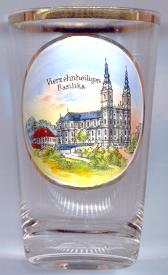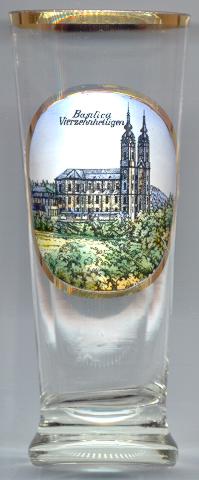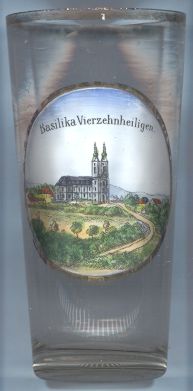

|
| DEUTSCHLAND | GERMANY |
| Bundesland: Freistaat Bayern | Bavaria |
| Regierungsbezirk: Oberfranken | |
| Landkreis: Lichtenfels |
 The pilgrimage church of
The pilgrimage church of  Vierzehnheiligen (Fourteen Saints) is situated high on a hill above the valley of the river Main
in Oberfranken and certainly is one of the most beautiful examples of Late Baroque and Rococo architecture
in the state of Bavaria. It was built 1743–1772 after plans of the famous architect Balthasar Neumann (1687–1753) (another famous pilgrimage church by
B. Neumann is the basilica of Gößweinstein).
the pilgrimage to this site goes back to the 15th century. According to the legend, in 1445 a shepherd saw a young child lying on a field. When
he tried to take it up, the child disappeared. Several months later, in 1446 he is said to seen the child again, this time surrounded
by 14 other children. They told him that they were the 14 auxiliary saints and wanted to have a chapel built in their honour.
The abbot of the monastery of Langheim later erected a cross on this site and began to build the first chapel.
Vierzehnheiligen soon became one of the most popular pilgrimage sites. During the Peasants' Wars and the Thirty Years' War the buildings
were destroyed but rebuilt each time on a larger scale. The Cistercian order had the spiritual care of the pilgrims until 1803, when they had to
leave following the secularisation which also included the closure of the monastery of Langheim. In 1835 a fire which was caused by a bolt of lightning
Vierzehnheiligen (Fourteen Saints) is situated high on a hill above the valley of the river Main
in Oberfranken and certainly is one of the most beautiful examples of Late Baroque and Rococo architecture
in the state of Bavaria. It was built 1743–1772 after plans of the famous architect Balthasar Neumann (1687–1753) (another famous pilgrimage church by
B. Neumann is the basilica of Gößweinstein).
the pilgrimage to this site goes back to the 15th century. According to the legend, in 1445 a shepherd saw a young child lying on a field. When
he tried to take it up, the child disappeared. Several months later, in 1446 he is said to seen the child again, this time surrounded
by 14 other children. They told him that they were the 14 auxiliary saints and wanted to have a chapel built in their honour.
The abbot of the monastery of Langheim later erected a cross on this site and began to build the first chapel.
Vierzehnheiligen soon became one of the most popular pilgrimage sites. During the Peasants' Wars and the Thirty Years' War the buildings
were destroyed but rebuilt each time on a larger scale. The Cistercian order had the spiritual care of the pilgrims until 1803, when they had to
leave following the secularisation which also included the closure of the monastery of Langheim. In 1835 a fire which was caused by a bolt of lightning
 destroyed the two towers and the roof of the church. In 1839, the Franciscan order was called to Vierzehnheiligen by King Ludwig I of Bavaria to revive the pilgrimage.
The roof was repaired, but the towers received their old appearance again only at the beginning of the 20th century.
A thorough renovation 1982–1990 restored the interior of the church to its original appearance. The works were completed with
the consecration of the new main organ in 1999. Since 1897 the church has the status of a Basilica minor; it was the first church in Germany that was
awarded this papal title.
destroyed the two towers and the roof of the church. In 1839, the Franciscan order was called to Vierzehnheiligen by King Ludwig I of Bavaria to revive the pilgrimage.
The roof was repaired, but the towers received their old appearance again only at the beginning of the 20th century.
A thorough renovation 1982–1990 restored the interior of the church to its original appearance. The works were completed with
the consecration of the new main organ in 1999. Since 1897 the church has the status of a Basilica minor; it was the first church in Germany that was
awarded this papal title.
(see also list of other basilicae minores depicted on glasses of this collection)
 The fourteen auxiliary saints are:
The fourteen auxiliary saints are:
St. Achatius († ca.305): helper in need, patron against persecution and fire etc.
St. Aegidius († 720): patron of shepherds and cattle, patron of nursing mothers etc.
St. Barbara († 306): patron of miners, architects, soldiers, artillerymen, masons and roofers etc.; guardian against sudden death, thunderstorms and fires.
St. Blasius († 316): patron of doctors, weavers, taylors, tanners etc.; patron of cattle etc.
St. Christophorus († ca.250): patron of mariners, raftsmen and travellers; patron against sudden death etc.
St. Cyriacus († ca.305): patron against temptations and evil spirits, patron in the hour of death, patron of wine-growers etc.
St. Dionysius († ca.250): helper against diseases of the head, agonies of conscience etc.; patron of France and the city of Paris.
St. Erasmus († ca.300): patron of seafarers, latheturners and shoemakers, helper against diseases of the stomach and belly etc.
St. Eustachius († ca.118): patron of hunters and foresters, helper in agonies of conscience etc.
St. George († ca.305): patron of knights, peasants, saddlers, blacksmiths, scouts and horses; shining example of christian virtue etc.
St. Katharina († 310); patron of teachers, philosophers, theologians, jurists, scientists, printers etc. etc.
St. Margareta († ca.307): patron of providers of nourishment, peasants; helper during birth, advocate of the poor etc.
St. Pantaleon († 305): patron of doctors, midwives and of the diseased; helper against headache etc.
St. Vitus († ca.304): helper against seizures, epilepsy, snakebites etc.; patron of the paralyzed and blind, of blacksmiths, coopers, innkeepers and brewers etc.
![[scale]](lineal.jpg)